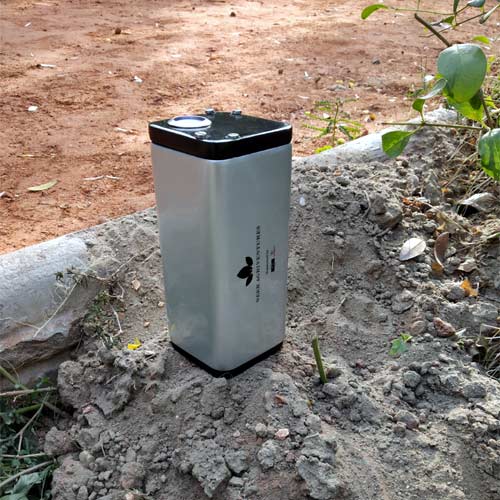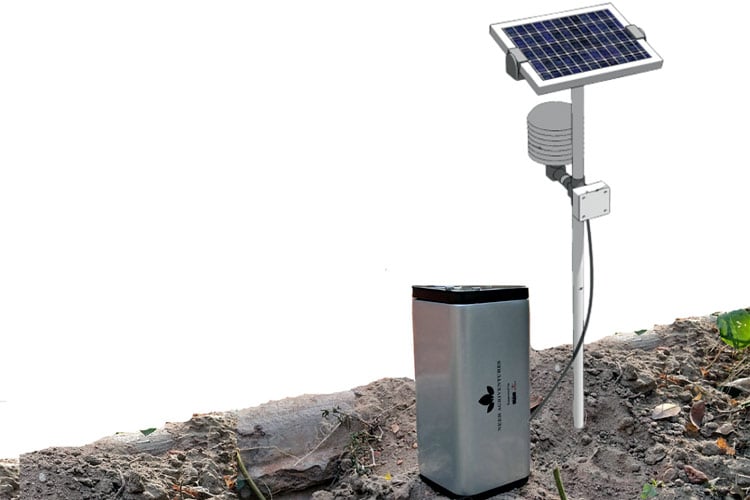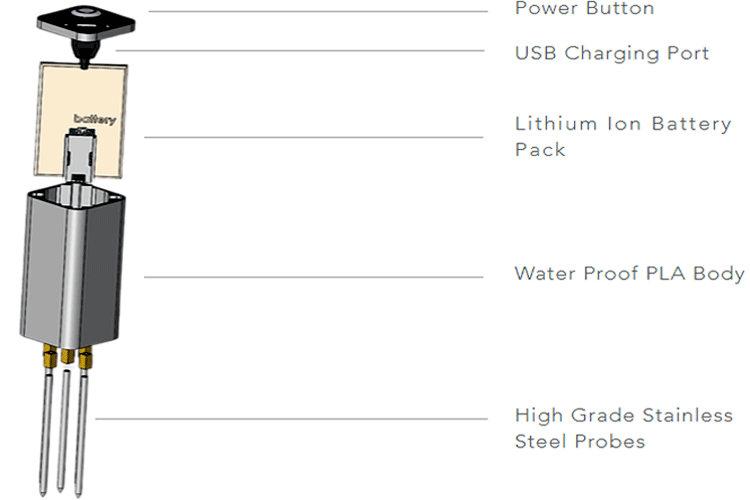
Soil health monitoring, irrigation scheduling, hi-tech greenhouses, evapotranspiration studies, watershed management, land reclamation, drought, flood forecasting, etc. play a vital role in farming. Farmers in India have been facing a lot of problems in terms of real-time and on-field data analytics. Undoubtedly, there are certain companies that offer the solution but the cost of imported and high-end technologies is so high that farmers can’t afford it.
To help combat the problem and let farmers heave a sigh-of-relief, two passionate engineers, Harsh Agrawal and Nikita Tiwari started NEERx Technovation in 2017. They developed a sensor called SHOOL (Smart sensor for Hydrology and Land application), which provides an accurate and real-time farm microclimate information using dielectric technology.
In the quest to know more about the startup, NEERx and their sensor, we asked the CEO of the startup, Harsh Agrawal a few questions to which his answers were quite interesting. As the CEO of the company, Harsh handles various responsibilities like product development, overall execution, finance, strategy, etc. He is an electrical engineer by profession but has experience in IoT, embedded, and wireless network solutions as well. Harsh derives motivation from a lot of peer entrepreneurs to align with vision and mission for his own startup. He is passionate to understand the bottom of pyramid problems and develop solutions that are innovative and scalable. Here is, what he has to say about agricultural conditions in India, challenges, solutions, and a lot more.
Q. Tell us something about your company and what problems does NEERx Technovation aims to solve?
Conventional methods of farming are becoming a great challenge for current day farmers as they do not have provisions for intelligence-based actions. Real-time crop and soil health data are not accessible. Especially in India, the cost of implementing imported technologies is too high and would never reach farmers in decades. A lot of companies are looking at data as gold but to generate such data out of agricultural fields requires high precision as well as accuracy. We started approaching this problem in 2017 with the bottom-up pyramid approach and crucially evaluated each and every aspect to ensure we build a solution that can really scale across India.
Q. NEERx has come up with a product called SHOOL i.e Smart Sensor for Hydrology and Land application. Tell us more about it and how it is different from existing Sensors.
NEERX’s product SHOOL is the first of a kind made-in-India sensor that has the ability to characterize soil medium and has been developed after two years of extensive research. After placing the sensor in the soil, it is able to wirelessly transmit the real-time condition of the soil. Existing sensors do not provide a variety of parameter that SHOOL can but there are some capacitive and resistive sensors which are threshold-based and fail badly in actual field performance whereas SHOOL provides absolute values having >97% accuracy(validated and reported). Our major competitors are companies based in the US, UK, and Australia, who are not offering economical solutions for Indian scenario.

Q. Apart from measuring sensor parameters, SHOOL also provides cloud analytics and real-time farm microclimate information using dielectric technology. Please share some details on how this data can be used.
Dielectric technology is the core of SHOOL for sensing. Using SHOOL and an array of other sensors real-time microclimate information is gathered and send to the cloud. This data can then be further used to link these parameters and derive drought-related information, pest infestation, heat stresses, germination rates, etc. The data serves as input to a lot of government agencies, remote sensing companies, agri-data analytics, and agri-focused companies for further data processing.
Q. Tell us about your solar-powered IoT Station, how does it work along with SHOOL? How is the data sent from the senor to the analytics platform?
Solar-powered station is specifically added for time-series data analysis using SHOOL and other sensors. Hourly data such as wind profiles, soil profile, temperature, humidity, rain, etc. are collected and sent to cloud servers via GSM/LTE modems.

The variability for the whole day, week, month, and the year is tracked with such a huge amount of data. This opens up space for actionable intelligence and predictions. A lot of coding is involved just to ensure no data packets go missing or haywire as IoT station would mostly be installed in remote locations.
Q. Comment on the battery backup of SHOOL sensors, what helps you to achieve this long-lasting power?
SHOOL has a great USP when it comes to power consumption as it outperformed all the existing sensors owing to the innovative algorithm deployed in SHOOL. The internal electronics of SHOOL also has been highly optimized to take down the wattage. More than 2500 data points can be sampled in a single charge.

Q. SHOOL sensors have an error margin of less than 3%, what helps you to achieve this high accuracy?
The accuracy of more than 97% has been achieved through a lot of failures and multiple field testing activities. While developing SHOOL, we focused on having a scientific approach and patience really played an important role to deliver the results. The efforts put in by our team even while it was 50-degree scorching sun just to ensure we have enough samples to validate our product resulted in something great.
Q. What are the common problems faced when deploying sensors in the actual agricultural field? How does NEERx Technovation deal with it?
The problem of deploying such sensors is an improper understanding of soil and its hydrology. There are protocols that need to be followed while installing such sensors. NEERX does a field survey to identify the most optimized way to place an array of sensors based on land topology, crop type, and a lot more other parameters. The data transmission systems we use have the capability to switch over to 2G/3G or 4G modes depending on the availability of network which really helps in remote installations.

Q. The product is currently being used by the Indian Space Research Organization (ISRO), Indian Agriculture Research Institute and other Agri-Universities and government bodies. How has this helped you outreach the masses?
Receiving appraises from such prominent institutes and partnering with them to foster this technology has worked wonders for us. The intellectual support as well as validation support that we have received from ISRO especially took us on a course of long roads of development. We leveraged their network and presence they have across India to ensure we reach out to a larger audience. Now they trust our product anytime better than even imported sensors due to the collaborative efforts.
Q. Besides farming, SHOOL can have applications in climate change studies too. Please shed some light on this.
A lot of recent studies have shown how climate change is damping out our natural resources. Therefore, monitoring our natural resources and reversing the climate change phenomenon is very important. With SHOOL, the Water and Energy cycles could be understood and what are the problems in land and hydrology exchanges can be figured out with long term deployments.
Q. NEERx is currently providing solutions in various cities. What steps is your team taking to make potential customers aware of the product?
The team is actively involved in business development to reach out to a wider audience. We now have our presence in more than 10 states which have agriculture as their primary activities. We tie up and hold pilots for various government organizations and PSUs to expand our reach. Our product is available on various government and business marketplaces for trade as well as direct use.

